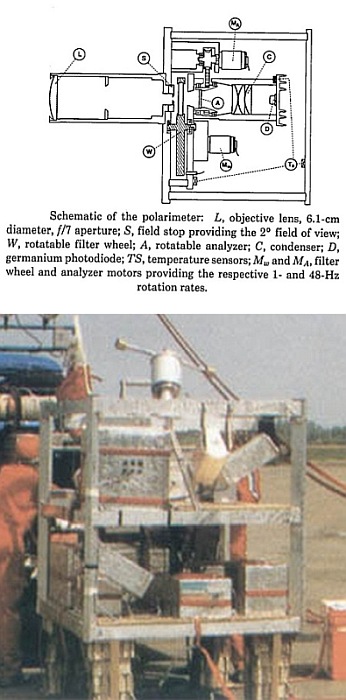Purpose of the flight and payload description
RADIBAL (RADIomètre BALlon) was a photo-polarimeter developed in 1982 by the Laboratoire d'Optique Atmosphérique (LOA), Université des Sciences et Technologies de Lille in France. Its goal was to measure at two near-infrared wavelengths, the radiance and the degree of polarization of sunlight scattered from the stratospheric aerosol at various angles.
A schematic of the polarimeter optical system can be seen at left and a view of the gondola on which it was mounted(click to enlarge) . The entrance radiance was spectrally filtered by a filter wheel (W), then passed through a rotating analyzer (A), and finally was focused on detector (D). The objective lens had a diameter of 6.1 cm; the field stop (S) in its focal plane provided a 2º field of view; the lens aperture was f/7. The condensed beam passed through the filters just behind (S) being its diameter 6 mm. There were two filters: one for the 850nm wavelength and the other for the 1650 nm wavelength with a diameter of 50 mm. Both filters were mounted on the rotating wheel (W). Given the respective diameters of the wheel, the filters, and the beam, each filter was full-beam positioned within a 48º rotation of (W). Since the detector sensitivity was quite constant regardless of the polarization state of the received light, the polarization analysis was provided by a simple rotating analyzer (Infrared H.C. Polaroid).
The double condenser (C) finally imaged the field stop into detector (D) a Judson germanium photodiode of 3-mm diameter. Given radiance computations for stratosphere standards on the one hand and the previous choices for the field of view, the entrance lens, and the spectral bandwidths on the other hand, the derived power budget showed that the degree of linear polarization could be measured within ±0.01 at 25-km altitude.
The germanium photodiode was operated in the photovoltaic mode at a temperature of -27.40 C, with the thermal regulation being provided by a cooling Peltier device. An inverting amplifier used for the first amplification stage bringed the signal up to a usable level. A second amplification stage imposed three different gain levels: X1, X10, and X100. Then the signal was taken by an analog-to-digital conversor resulting in a 12-bit digitized stream which was treated by an onboard Intel 8085 microprocessor; thus, after a full revolution of the filter wheel the onboard telemetry system transmited the data stream along with several housekeeping parameters and positioning information to the ground station.
The entire instrument was packaged in three distinct units: the polarimeter with its detector amplification system, the data processing electronics, and the battery supply. These unpressurized units were thermally insulated by polystyrene housings. Moreover, a heater was incorporated in the polarimeter unit, so when temperature reached -7°C, the cooling Peltier device of the detector was activated.
The polarimeter was fixed on a stratospheric platform carefully leveled before the launch whose angular scan was provided by a nominal spin rate of 1 rpm. The horizontality of the observation direction was checked from an onboard inclinometer while the azimuth was obtained from an onboard magnetometer. Finally, the solar elevation and azimuth were obtained from the balloon geographical position along with the time of the measurement.
Details of the balloon flight
Balloon launched on: 4/22/1985
Launch site: Centre de Lancement de Ballons CLBA, Aire Sur L'Adour, Landes, France
Balloon launched by: Centre National d'Etudes Spatiales (CNES)
Balloon manufacturer/size/composition: Zero Pressure Balloon
End of flight (L for landing time, W for last contact, otherwise termination time): 4/22/1985
External references
- RADIBAL website Laboratoire d'Optique Atmosphérique
- Validation of SAGE II data inversions by the European correlative experiments Advances in Space Research, Volume 7, Issue 3, p. 227
If you consider this website interesting or useful, you can help me to keep it up and running with a small donation to cover the operational costs. Just the equivalent of the price of a cup of coffee helps a lot.


